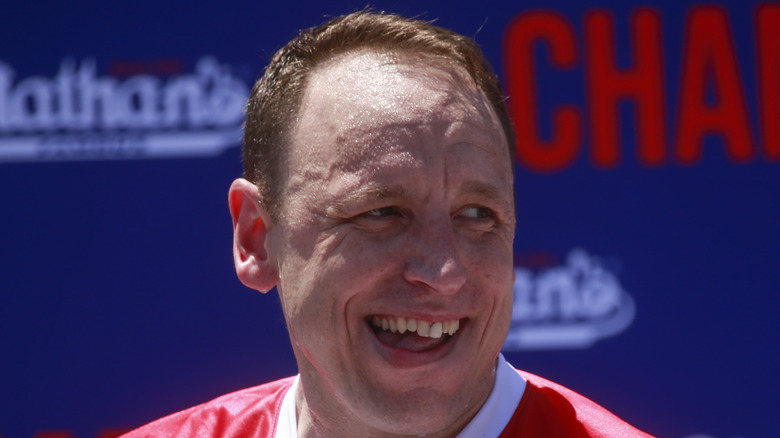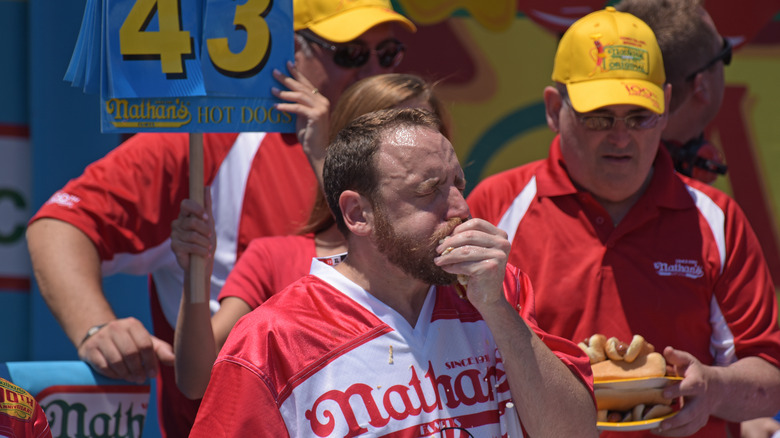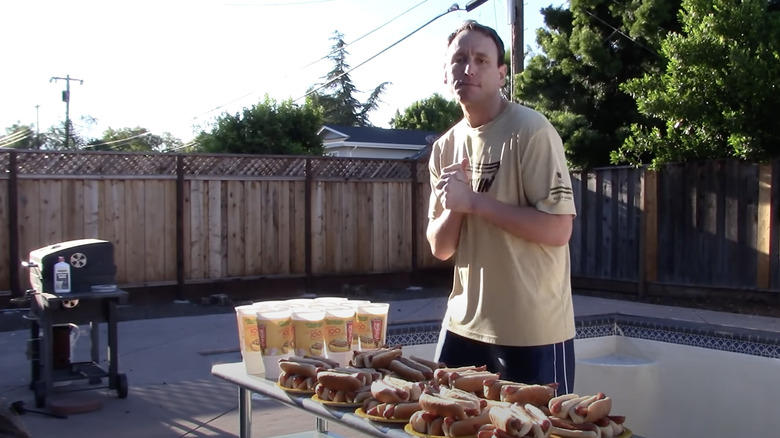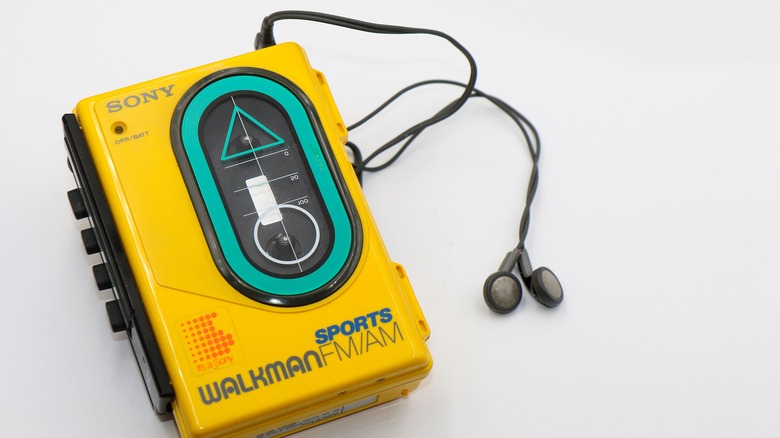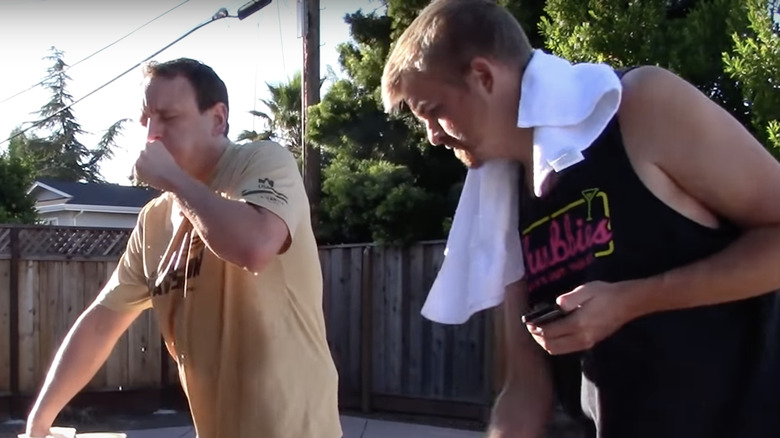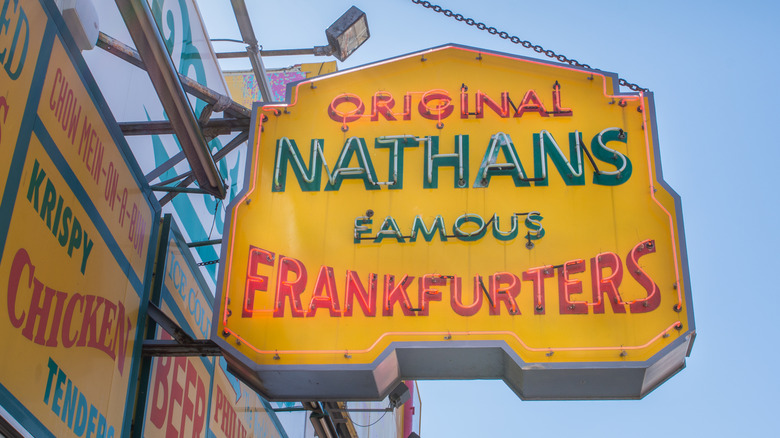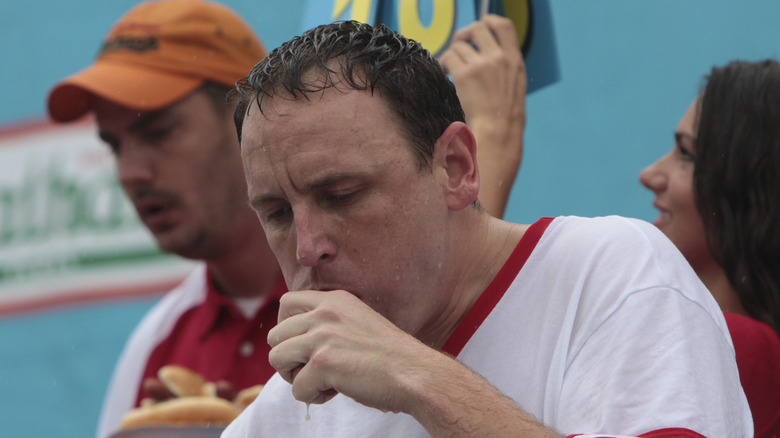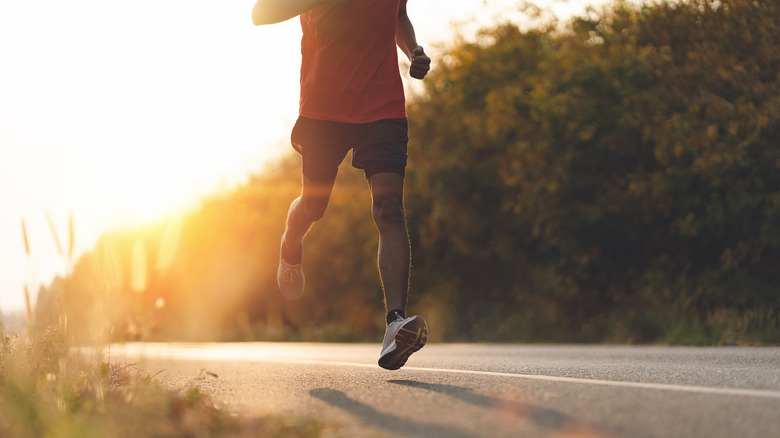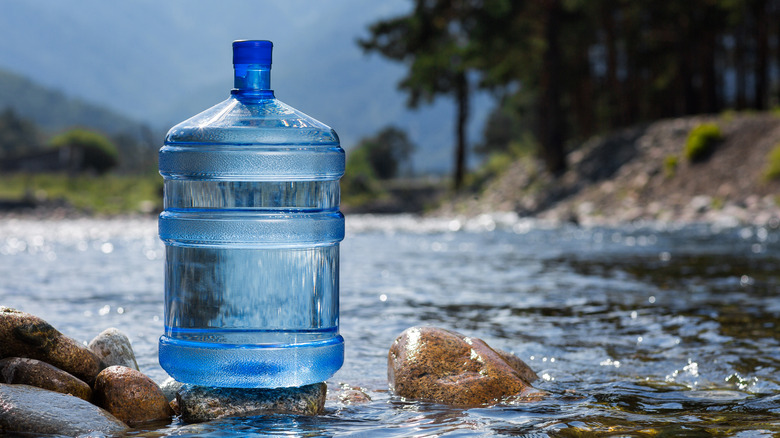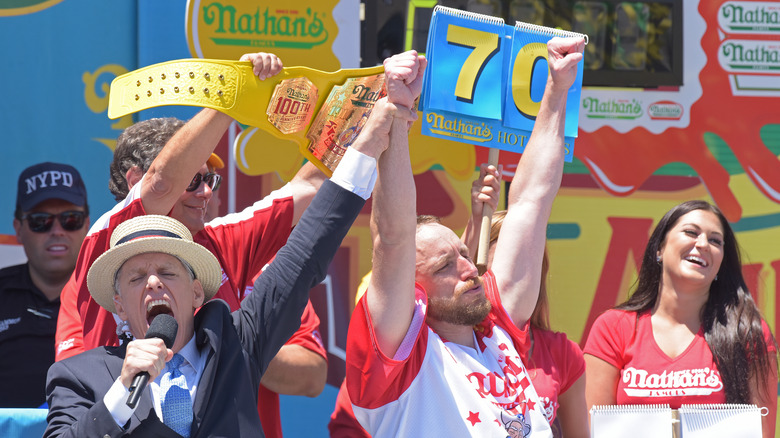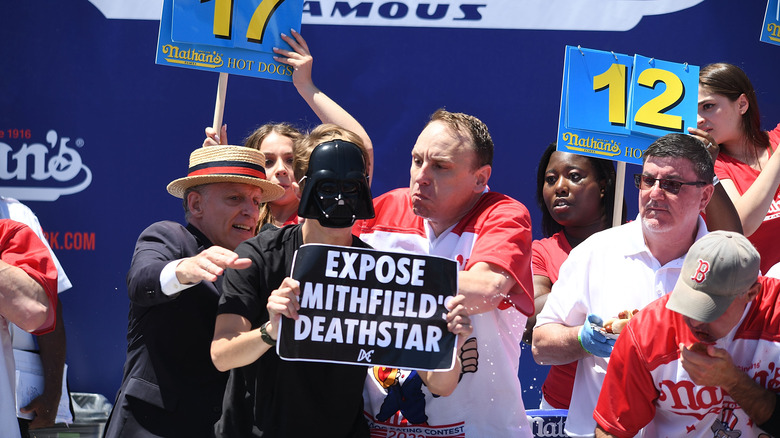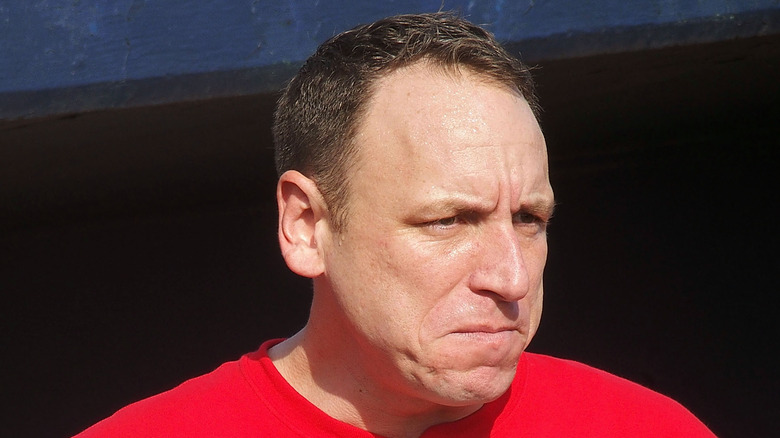How Joey Chestnut Gets In Shape For His Hot Dog Eating Contests
There are competitive eaters, and then there is Joey Chestnut. His Major League Eating bio states unequivocally that he is the best professional eater of all time. His list of accomplishments is dizzyingly long. He owns the world record for most hot dogs eaten in 10 minutes (76), as well as 54 other world records for eating just about any food you could imagine, and some you can't (we're looking at you, brain tacos). His 55 world records make him the world record-holder for the most world records.
On July 4th, 2022, Chestnut won the Nathan's Hot Dog Eating Contest for the 15th time, despite interrupting his eating in order to tackle a protestor who was trying to disrupt the action (via The Washington Post). Chestnut barely had to pause Hoovering hotdogs to dispatch the protestor.
Whether or not you think competitive eating is a real sport, it's undeniable that Chestnut has a special set of skills. And just like any physical skill set, Chestnut's eating prowess has been honed through long hours of intense physical training. Of course, the training for competitive eating doesn't look exactly like the regimens favored by athletes in the NBA, NFL, or MLB. Instead, Chestnut uses a highly unorthodox set of techniques to train his body to eat 70 or more hot dogs in 10 minutes. We've done the research to find out how exactly Joey Chestnut gets in shape for hot dog eating contests.
He exercises the muscles in his jaw and neck
You might think of competitive eating as mainly a test of stomach capacity, but that's only part of the package needed for success in the Nathan's competition. In reality, chewing and swallowing all that food takes a toll on your jaw and throat muscles. As Chestnut told Delish, his throat usually becomes tired around seven minutes into the competition, forcing him to shimmy his entire body so the hot dogs slide down his neck.
Per ESPN, competitive eaters have to train the Masseter muscle, which is responsible for moving your jaw up and down. Some eaters who ESPN tested had bites stronger than that of a German shepherd dog, already known for its considerable bite force. ESPN mentions that chewing gum is a popular way to exercise this muscle, but Joey Chestnut uses a different technique.
The ESPN documentary "The Good, The Bad, The Hungry," which profiles Chestnut and his former rival, the Japanese competitive eater Takeru Kobayashi, gives viewers unprecedented access to Chestnut's training techniques. The Nathan's champ works out his jaws and neck with a self-designed training regimen. In it, he chews a small rubber ball for jaw strength and does head lifts while carrying a weight in his teeth to exercise his neck. To strengthen his throat, he gulps air while doing small crunches on a weight bench. This regimen improves his bite strength and allows him to swallow pounds of food before becoming tired.
His practices mirror the conditions of the actual contests
Joey Chestnut knows that in order to properly train for the Nathan's Hot Dog Eating Contest, he needs to replicate the actual contest conditions as closely as possible. In a promo video for the 2021 contest, he explains that during his last few practice runs before every contest, he does everything he can to make it feel like he's really competing (via YouTube). To that end, he practices outside so he can prepare for the muggy heat of Coney Island in July, which makes his feats of digestion all the more difficult, according to Forbes. He even uses competition-regulation plastic water cups for drinking and bun-dunking.
He also stays true to the real competition by adhering to the contest's time limit and the number of hot dogs he eats during practice. Per GQ, not every practice run is full-strength, but during the ones that are, Chestnut will regularly eat 70 or more hot dogs. Chestnut claims in the 2021 promo video that he's broken 80 dogs in 10 minutes a few times in his training sessions, a number he's never reached during the actual event.
Joey Chestnut listens to the previous year's competition to get him in the zone
One aspect of the Nathan's Hot Dog Eating Contest that's hard to replicate at home is the thrilling atmosphere of the big day. In the lead-up to the event, each contestant gets a professional wrestling-style introduction from Major League Eating Chairman George Shea, while a huge crowd gathers around the contestants to cheer and scream. Eating 70-plus hot dogs alone in the comfort of your own home probably doesn't get the heart pumping in exactly the same way.
Joey Chestnut tries, however. At home, he simulates the electricity of an amped-up audience by listening to a recording of the previous year's competition while practicing for the next one. You can see him doing this both in "The Good, The Bad, The Hungry" and in a video he uploaded to his own YouTube channel. He even waits to eat his first hot dog until the recording of contest MC George Shea counts down and says "Go!" It's almost like he's eating hot dogs in time with the one-year-ago version of himself. This can be strategic, too, as he mentions in his YouTube video that following along with the recording allows him to make sure he's keeping a winning pace. Of course, he's almost always winning in the recording of the previous year's contest, so we imagine that the audio helps him visualize victory as well.
He has his roommate shout encouragement at him
One way Joey Chestnut's training sessions differ from the contest is that he has someone coaching him while he eats. In "The Good, The Bad, The Hungry," that coach is identified as Chestnut's roommate Aaron Stroope, and it appears to be the same man in a 2017 YouTube video of a Chestnut training session.
Stroope's role seems to be less about giving strategic advice and more about being a hype man. In the 2017 video, he repeats the same few affirmations over and over again in a hypnotic mantra: "You got this, Joey, c'mon, let's go, you can do it." In "The Good, The Bad, The Hungry," Chestnut discusses how his training session went with Stroope after he finishes eating, but it seems like Stroope is there more as a sounding board for Chestnut than as a coach in the traditional sense.
Stroope also helps out with practical things like manning the stopwatch and moving the plates of hot dogs so that Chestnut doesn't have to reach across the table for his next dog after he clears a plate. Perhaps most crucially, we see Stroope cooking hot dogs in the ESPN documentary, keeping watch over two large countertop griddles packed with Nathan's Famous franks.
Joey Chestnut practices with Nathan's hot dogs
Chestnut's commitment to verisimilitude extends to his choice of practice hot dogs. He told GQ that he insists on using Nathan's Famous franks, the same dogs that are eaten in the actual competition. When he lived on the West Coast, however, he had trouble finding Nathan's franks in grocery stores, so he ended up having the company ship hot dogs to his house.
While you might think all hot dogs are just about the same, our hot dog brand ranking shows that's simply not the case. There are big differences in taste, texture, and size between different hot dog brands. And wouldn't you know it: Nathan's Famous was actually the number one hot dog in our ranking. If you're going to eat several dozen hot dogs on live TV, you might as well eat the best.
The size of the hot dogs was actually a source of some controversy. Takeru Kobayashi, Chestnut's erstwhile rival, once told TMZ Sports that Nathan's hot dogs have gotten smaller in recent years (via YouTube). He suggested that the shrinking dogs might be one of the reasons that Chestnut has steadily increased the number of hot dogs he can eat in the competition.
He follows a special diet
When he's training for the Nathan's Hot Dog Eating Contest, Joey Chestnut follows a very restrictive diet. The goal of his eating regimen is to help him recover from his hot dog eating practice sessions as quickly as possible. As he told ESPN, after a practice session, "As soon as I can start eating, I try to eat vegetables, fiber. And then once I feel like the food has moved and digested, I'll have one good day of protein, whether it's fish or turkey, maybe chicken. And then I go back and do a fast, where it's all liquid. It's a cleanse, pretty much, a two-day cleanse." After the cleanse, he's ready to take on another practice run.
He told GQ that the cleanse portion of his diet consists mainly of lemon water. The diet reportedly keeps his metabolism running quickly, so despite all of the hot dog calories he eats during his weeks of training (Chestnut estimates that 70 hot dogs comes out to around 20,000 calories), he usually loses a significant amount of weight before the Nathan's contest. According to Chestnut, in 2015, he lost a little over 20 pounds while training.
Joey Chestnut exercises to keep his body in good physical shape
You would expect competitive eaters to pack on the pounds, given that they earn their living by gorging on thousands of calories of food at a time. But the truth is that many top-level competitive eaters are surprisingly slender. Some, like 2015 Nathan's champion Matt Stonie, are straight-up skinny. One potential reason why competitive eaters try to stay trim is the belt of fat theory, which, per Salon, was dreamt up by '90s competitive eater Ed Karachie. Karachie surmised that if you had excess abdominal fat, it could constrict the amount your stomach was able to expand, thus hampering your ability to dominate eating competitions.
The belt of fat theory may or may not hold water, but either way, we know that Joey Chestnut works out to keep himself relatively trim. According to CNBC, his workout regimen includes yoga and running. Per Forbes, the running helps Chestnut develop his breathing technique, which in turn improves his hot dog-eating ability. In 2009, Chestnut trained with 12-minute sprints because the Nathan's contest was 12 minutes long back then.
Chugging liquids helps stretch out his stomach and exercise his throat
In addition to the specialized neck and throat workouts mentioned above, Chestnut has another technique for improving his swallowing ability: chugging fluids. In 2015, he told GQ that he starts every training day by drinking a gallon jug of water. As if that weren't enough to make your own stomach ache, he tries to drink it with as few swallows as possible. Chestnut estimated that, on average, it takes him 12 gulps to polish off a gallon of water. By our math, that works out to about 10.66 ounces per gulp. That's almost an entire soda can's worth of fluid in just one swallow.
It seems as though the particulars of Chestnut's liquid intake have changed somewhat over time. In a 2009 profile, Forbes said that he drank a half-gallon of milk every morning when he was training. Apparently, the milk helped to expand his stomach. At the time, Chestnut said that he could chug an entire gallon of milk in 40 seconds.
Most of his methods are self-taught
As Chestnut says about competitive eating in "The Good, The Bad, The Hungry" documentary, "It's not something that there's books written about. There's no trainers. It's all trial and error." Most, if not all, of Joey Chestnut's eating-specific workout and training techniques were developed by him alone. This means that I t took him years to accumulate the knowledge and techniques necessary to transform himself into the best competitive eater of all time. According to Chestnut, "I had to work my butt off to understand my body" (via CNBC).
Much of Chestnut's progress comes as a result of paying close attention to how his body works. He credits his engineering degree with giving him the tools to approach the problems of training and competitive eating scientifically. As he told CNBC, "I definitely try to solve everything like it's a problem." He even records all of his meals, as well as what they did to his body, in a notebook so he can identify patterns and further refine his training regimen.
Doctors and nutritionists have given him advice
Although most of Chestnut's training methods were self-developed using trial and error, that doesn't mean he disregards the advice of professionals. According to Forbes, at the beginning of his competitive eating career, Chestnut happened to be enrolled in a college nutrition course. Chestnut's first training regimen was based on advice from his nutrition professor. Of course, his methods have evolved over the years. He also frequently visits doctors for checkups and asks them for advice (via CNBC).
We're happy to hear that, as competitive eating can be dangerous to your health. In fact, the dark truth of eating contests is that performers often injure themselves in their quest to consume as much as possible in one sitting. The damage wreaked upon their bodies can range from arthritis of the jaw to internal bleeding. That's not to mention potential long-term consequences like chronic stomach problems.
However, according to Chestnut, his doctors tell him he's fine and say he's not at risk for a ruptured stomach (via GQ). In an interview with TMZ, he said that he plans to keep on competing as long as he can, provided his doctors continue to say he's healthy.
A leg injury complicated his training in 2022
By now, it's pretty clear that exercise and physical preparation play big roles in Chestnut's usual training regimen. However, he wasn't able to exercise as much in the run-up to the 2022 Nathan's contest because he had ruptured a tendon in his leg. The injury was so serious that he had to walk with crutches when he showed up to the contest's weigh-in ceremony (via Sports Illustrated). At the time, Chestnut dismissed any worries about how the leg would affect his showing at the competition, saying, "I'm gonna eat like a madman."
In an interview with an Indiana Fox affiliate, Chestnut did admit that he would have to modify his usual strategy during the contest because of his injury (via YouTube). He said that his injured leg would prevent him from bouncing around onstage to force the food down. He also mentioned that the injury meant he couldn't run or ride his Peloton and that he had to practice less in 2022.
Yet, if anyone thought that Chestnut's injury would create an opening for another eater to take the Nathan's crown in 2022, they were mistaken. As the New York Post reports, Chestnut ate 63 hot dogs in 2022, beating the runner-up Geoffrey Esper by 20. This feat was made even more impressive by the fact that he wore a medical boot during the event and was involved in a physical altercation with an animal rights protestor while he was eating.
The aftermath of the competition is no picnic
Just as the preparation for the Nathan's Hot Dog Eating Contest requires strategy and physical fortitude, so does the aftermath. Chestnut told Insider that the contest takes a lot out of him. "Most people relate to feeling really bloated and tired after Thanksgiving ... It's kind of like that, except really, really bad." The amount of hot dogs he consumes even affects his sweat, which changes texture and starts to smell like hot dogs.
Right after a competition, all Chestnut wants to do is sleep and drink fluids. Then, he needs to start going to the bathroom. Not to get too graphic, but everything that comes in must go out, and Chestnut says his unique training diet ensures that evacuation happens pretty quickly. In his interview with FOX59, he stressed the importance of eating regular meals with fiber in the days after the competition. He claimed that if he just stops eating post-contest, the hot dog weight stays on him and his digestive system grinds to a halt.
Although the immediate aftermath of the competition is pretty rough, Chestnut rebounds quickly. After a couple of days, he's already up and ready to eat big meals again (via TMZ). Doing the contest hasn't made him sick of hot dogs, either. As he put it to Insider, "Runners, they look like they're going to die at the end of a marathon but they still love to run ... I love a good hot dog."
